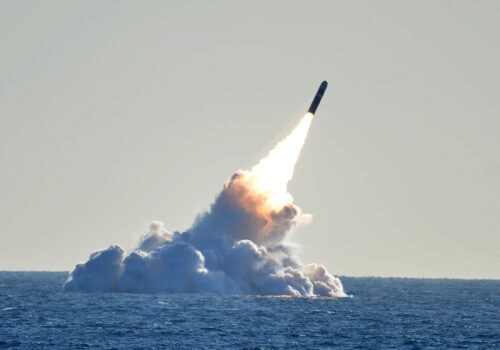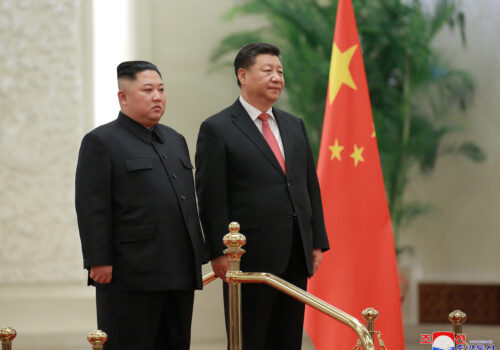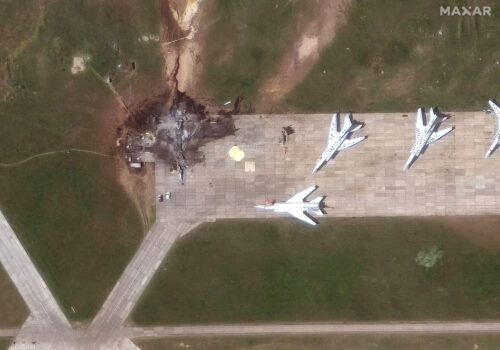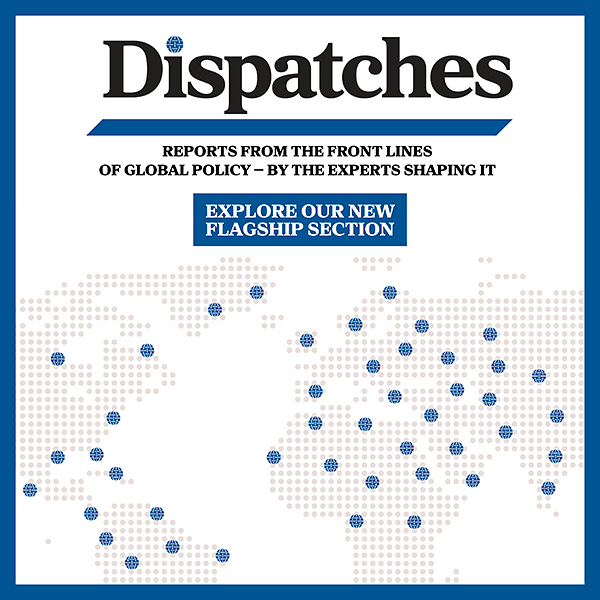In defense of the US maintaining a balanced nuclear triad
The United States has long relied on a nuclear triad of land-based intercontinental ballistic missiles (ICBMs), strategic bombers, and nuclear-powered ballistic missile submarines (SSBNs). This combination, which the past four US presidential administrations endorsed, is the best way to maintain effective deterrence at a reasonable cost. But new risks loom on the horizon, and defenders of the triad should take note that potentially expedient US government decisions made in the coming years could inadvertently undermine the triad’s continued viability.
The three legs of the triad are mutually supporting, making the whole greater than the sum of its parts. The SSBN force is widely seen as the most survivable leg in a conflict, as SSBNs have been virtually undetectable when at sea. ICBMs are often viewed as the most responsive leg, because they are on alert and ready to launch any time day or night. Strategic bombers are the most flexible and visible leg, because they can be alerted, dispersed, and forward-deployed in plain sight to provide both assurance to allies and deterrence against adversaries.
Together, the triad’s three legs provide many benefits. The triad offers enhanced survivability and, thus, assured retaliation. It offers strategic stability through redundancy of options, as well as flexibility in both crisis and conflict. It offers the ability to tailor deterrence to diverse adversaries, as well as the ability to mitigate risk related to technological breakthroughs or geopolitical realignments.
Changes in triad composition that significantly alter the proportion of US nuclear capabilities fielded among its three legs, combined with new, nonnuclear adversary attack vectors, could invite preemptive, nonnuclear attack in ways that could undermine deterrence and the United States’ ability to employ its nuclear capabilities in a conflict. The strength of the triad is a function not just of the existence of its three legs, but also of the balance in numbers and capabilities among the three legs. Any changes that disrupt this balance may introduce new vulnerabilities into one or more of its legs, thereby undermining deterrence.
Introducing vulnerability
The Trump administration is unlikely to abandon the triad outright, and its support for the existing nuclear modernization program seems solid. However, there are growing stressors that might lead to decisions that could undermine the triad’s continued effectiveness and credibility. This could manifest if the United States either reduces its commitment to one of the legs of the triad or improvidently increases its reliance on one leg at the expense of the others. The United States must not just maintain the triad. It must also maintain balance among its three legs to ensure it possesses the correct mix of attributes that US nuclear deterrence policy and posture have come to rely on to maintain stability and the capacity to achieve national objectives in the event of conflict.
Three examples of these stressors illustrate the risks if warhead imbalances are introduced into the triad in the coming years.
First, SSBNs have long been considered practically invulnerable to adversary attack and, as a result, the leg upon which the United States relies for its second-strike capability. With this in mind, some commentators have suggested an increased reliance on SSBNs or that Washington should purchase more of them. This could disproportionately increase the number of weapons in the SSBN leg relative to the other two.
Second, because of the growing cost of the Sentinel ICBM program* (estimated at 81 percent higher in 2024 than the 2020 estimate), the US Air Force has admitted that it must decide whether to stay with the current Sentinel ICBM acquisition strategy or significantly change it (a process that is ongoing). Congress has staunchly supported Sentinel, and the Pentagon has shown no signs that it will abandon the current plan to replace the Minuteman III ICBM with the Sentinel on a one-for-one basis. However, if costs continue to rise so sharply, then it could create pressure to pursue other avenues, potentially resulting in a smaller number of deployed Sentinels, a fielding approach with fewer key nodes for adversary attack, or, perhaps, a pivot to an entirely different system that results in fewer fielded missiles but a larger number of warheads. This could reduce the number of ICBMs in the land leg relative to the other two.
Third, because the B-21 Raider* program is proceeding apace, some are calling for the purchase of a greater number of B-21s. All else being equal, this could increase the bomber leg relative to the other two.
Emerging threats
Any one of these potential posture changes may be a logical response to factors such as how the security environment is changing, what funds are available, or what is feasible in the short term from an acquisition perspective. However, any such posture change should be approached cautiously for fear that it could introduce vulnerabilities into the triad. Such vulnerabilities could arise by US policymakers failing to account for evolving threats or by unintentionally providing adversaries perverse incentives for preemptive attacks in ways that US strategists and planners had not previously envisioned.
For example, emerging technology is heightening risks to the triad’s sea leg. Unmanned surface and subsurface drones threaten to make US submarines incrementally easier to find, fix, and track. Similarly, quantum sensing technologies hold the potential to render submarines more detectable by using advanced acoustics, magnetometry, and gravimetry. While the threat posed by these evolving capabilities in the near term may be limited by the vastness of the ocean and the tactics, techniques, and procedures adopted to mitigate risks, the Defense Intelligence Agency warned in May that quantum technologies are nearing battlefield relevance. Given the small number of SSBNs (especially when they are not on a heightened alert status), and the correspondingly large share of deployed warheads that these SSBNs carry, such developments may introduce new and destabilizing vulnerabilities to US nuclear posture if SSBNs and their missiles come to represent a disproportionately large share of the overall US nuclear arsenal.
A similar concern applies to US strategic bombers. The B-2 Spirit* and B-52 Stratofortress are based in the continental United States on open ramps or unhardened aircraft hangars. Publicly available information suggests that the B-21, when fielded, will be located in unhardened environmental protection shelters similar to the B-2. Ukraine’s Operation Spiderweb, conducted in June 2025, should give US policymakers pause. Ukrainian special forces attacked and damaged or destroyed more than forty Russian strategic bombers from within Russian territory with unmanned aerial vehicles. This operation is a potential blueprint for how China or Russia could attack US strategic bombers with assets from within the United States.
US ICBM silos and launch infrastructure are not immune to these increasing risks either. In a crisis or conflict, drones carrying munitions or even shaped charges launched from US farmland or other locations near ICBM missile fields could conceivably interfere with the United States’ ability to launch ICBMs quickly by attacking launch control centers, critical command-and-control infrastructure, and/or the missile silos themselves.
In light of such increasing and emerging risks, the United States should continue to field a balanced proportion of capabilities among the three triad legs. Increased emphasis on one leg or a decreased emphasis on another could introduce vulnerability to the triad that Washington will later regret—especially as it takes years to field new or different capabilities due to challenges in the defense industrial base and nuclear enterprise. As US policymakers consider potential changes to the size, posture, or composition of US nuclear forces, they must account for these considerations—and recognize that the consequences of the choices they make today will play out over decades.
Paul Amato is the former director for nuclear deterrence policy in the Office of Secretary of Defense for Policy. He is a retired Marine infantry officer with twenty-eight years of active and reserve service. Before his government service, he was a practicing lawyer in the private sector. The views expressed in this article are his own.
Note: The Atlantic Council’s Scowcroft Center for Strategy and Security conducts work on nuclear and strategic forces that is supported by donors including Lockheed Martin Corporation, Los Alamos National Laboratory, Northrop Grumman Corporation (which is the prime contractor for the Sentinel ICBM, the B-21 Raider, and the B-2 Spirit), RTX Corporation, the Smith Richardson Foundation, the United States Department of Defense, and the United States Department of State, as well as through general support to the Scowcroft Center for Strategy and Security.
Further reading
Fri, Apr 11, 2025
The imperative of augmenting US theater nuclear forces
Report By
The United States and its allies and partners face an impending change in the threats they face from nuclear-armed adversaries: a strategic environment marked by two nuclear peer major powers.
Mon, May 12, 2025
A rising nuclear double-threat in East Asia: Insights from our Guardian Tiger I and II tabletop exercises
Report By Markus Garlauskas, Lauren D. Gilbert, Kyoko Imai
A decade from now, the United States will face even tougher challenges in the Indo-Pacific than it does today. With this in mind, the Atlantic Council's Guardian Tiger tabletop exercise series is preparing mid-level government and military leaders to address such threats.
Fri, Jun 6, 2025
Ukraine’s drone strikes offer four big lessons for US nuclear strategists
New Atlanticist By Mark J. Massa
Ukraine’s Operation Spiderweb should spur the US government to address strategic vulnerabilities that nuclear strategists have focused on for years.
Image: A composite of maintenance on a launch tube at FE Warren Air Force Base, Wyoming, July 9, 2025 (US Air Force photo by Staff Sgt. Michael A. Richmond); a B-2 Spirit at Whiteman Air Force Base, Missouri, May 9, 2025 (US Air Force photo by Senior Airman Bryson Sherard); and the Ohio-class ballistic missile submarine USS Kentucky (US Navy photo by Mass Communication Specialist 1st Class Ryan Riley).



